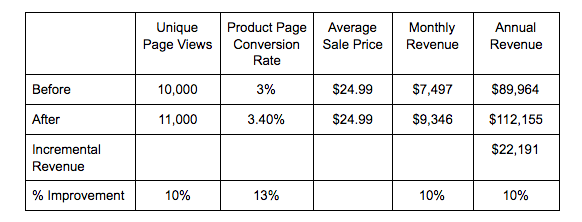Finding Your Product Content Management ROI | Salsify
Written By: Josh Mendelsohn
 One of the top questions that we get when working with new customers - whether they are brand manufacturers, retailers, or distributors - is how do you measure the ROI of product experience management? It feels like a complicated question. After all, investing in PXM can improve content accuracy and brand consistency. While those are benefits that impact online (and increasingly offline) sales results. It is really hard to attach an exact dollar amount to improvements. Product experience management can also have a big impact on productivity because it’s way easier for internal teams to collaborate cross-functionally and ultimately allow internal consumers of content to find what they need to be successful. But again, it is hard to quantify that one.
One of the top questions that we get when working with new customers - whether they are brand manufacturers, retailers, or distributors - is how do you measure the ROI of product experience management? It feels like a complicated question. After all, investing in PXM can improve content accuracy and brand consistency. While those are benefits that impact online (and increasingly offline) sales results. It is really hard to attach an exact dollar amount to improvements. Product experience management can also have a big impact on productivity because it’s way easier for internal teams to collaborate cross-functionally and ultimately allow internal consumers of content to find what they need to be successful. But again, it is hard to quantify that one.
The Right KPIs for Product Content Performance
Luckily there are some key performance indicators that can help us get to a Product Content Experience ROI (yay for math!)
- Product Page Traffic: How many people are visiting a product page driven by search results and advertising? We know that detailed product content drives better on and offsite search results. Based on Google’s own research we know that small changes can have huge impacts on how often your products are seen by a potential buyer. For example, Google found that including more attributes in product listings such as product material and colors caused impressions to rise between 10 to 20 percent.
- Product Page Conversion: How many people that visit a product page on a given site are adding the product to their cart and hitting the buy button? Research shows that pages with great product content perform better. In fact, Mondelez has seen high double digit increases in conversion based on enhancing their product content on Amazon.
- Days to Market: How long does it take to launch a new product on a sales channel? Increasingly retailers are asking for more and more product content directly from the brands before they can begin selling merchandise online. In order to get new products to market faster - and to update or refresh existing product promotions quickly - brands and retailers need a product content management process and technology in place. For example, Simpli Home, has cut their product launch time by 75% with Salsify’s Product Content Management Platform.
- Active SKUs: How many SKUs are launched and sold on key retailers? Pulling from a trusted source of content for every SKU makes it easier to share a wider assortment with folks like Walmart or Google. One example of this is Bosch, who recently published 5,700 products to Google Shopping in one week using Salsify.
- Total Selling Days Per Product: How many days is each product available for purchase? Every additional day that a product is in market can be a revenue driver for your business. No one is buying products that aren’t available for sale and that revenue simply vanishes into thin air. It can also help you maximize the sales of seasonal items by getting them into market first and thereby extending the “season” itself.
Basic Frameworks for Calculating Product Content Management ROI
Using some of those data points, there are two relatively basic frameworks we can use to start calculating ROI. The examples below use simple (and somewhat conservative) numbers but you can plug in your own data. I've drawn my conversion rates from ecommerce averages. Trust me, the numbers add up fast!
Version 1: Increased traffic x Higher conversion Rate = More Revenue
The first framework for measuring the impact of product experience management is through the lens of a traditional marketing funnel - from page views to sales. In the example below, a snack foods maker sells a 4-pack of large bags of potato chips for $24.99. They have invested in product experience management to improve findability and conversion and seen for this product alone a 10% increase in revenue based on getting improved content into market. Multiply that across a product line and/or multiple brands and…. Well, you get the idea.

The bottom line: In this scenario, a 10% increase in unique pageviews and a lift in product conversion rate led to a 10% increase in annual revenue for one product page alone. Numbers like this can show your team and your supervisor the direct correlation between investing in product content leading to more product sales.
Version 2: Days to Market Improvement x Products Launched x Sales Per Day x Price = Incremental Revenue
In this framework, the business is focused is on improving the speed of new product introductions to increase the number of selling days for a given set of products. For example, if you are launching 50 new premium t-shirts which sell for $13.99, and you can get 22.5 additional selling days per product, there is a significant increase in revenue simply by getting to market faster.

The bottom line: In this scenario, a faster time to market resulted in more 3 more weeks of sales time and more than $300K in additional revenue. In some cases a faster time to market could allow a brand to release products to more retailers or launch more products in key marketplaces. For retailers that rely heavily on search or recommendation engines, a faster times to market can also mean the difference between ranking higher in your product category.
Ultimately, investing in product experience management makes it possible to thrive in ecommerce. But initially you may have to show your work and your math to demonstrate the value to others in your organization. Effective product experience management requires a change in people, processes, and technology. By connecting your investments in process and technology to incremental revenue, you’ll be able to get everyone in your organization on board and show how important product content can be.
Written by: Josh Mendelsohn
Josh Mendelsohn (he/him) is a product marketing expert and former head of product marketing at Salsify, where he led efforts to position the company’s solutions and drive customer adoption.
Recent Posts
Do Brands Need Social Media Influencers In The Age of AI?
How Can Brands Align With Consumers’ New Year’s Resolutions?
5 Ecommerce Tips To Help Marketers Enter the New Year Stress-Free
Subscribe to the Below the Fold Newsletter
Standing out on the digital shelf starts with access to the latest industry content. Subscribe to Below the Fold, our monthly content newsletter, and join other commerce leaders.


.svg)